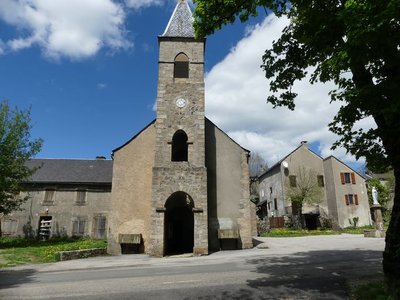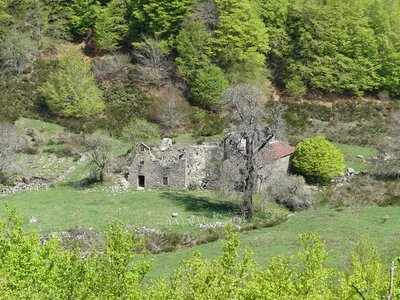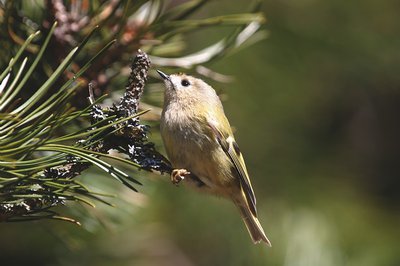
MTB 7 - The Bonheur valley – graded blue
3 points of interest

Camprieu - nathalie.thomas  History
HistoryCamprieu
In the 19th century, the village streets were bustling year-round with a throng of artisans, labourers and shopkeepers, who lived in these modest mountain houses that were also suitable for livestock rearing. Camprieu had: two cobblers, six clog makers, two basket makers, one carpenter, two wheelwrights, two farriers, one miller, two stonemasons, one glassworks, one sawmill, one dairy, two grocer’s shops, a haberdashery and ironmonger’s and one shop for ladies’ “fashion and dresses”. There was also a cheese cellar that produced Roquefort until 1932, a hotel and an inn.
L'Abbaye de Notre-Dame-du-Bonheur - nathalie.thomas  History
HistoryNotre-Dame-du Bonheur
This Romanesque monastery was built in the 11th and 12th centuries by the rich Lord of Roquefeuil and Mandagout, with the noble intention of turning it into a “hospital for the poor”. He allowed the monks to reap the fruits and revenue of the land. In return, the villagers paid him sheep, pigs, poultry, wine and cheese. He also charged the transhumant herds on his vast estate pasture fees. The path that passed through this peatbog linked Languedoc to the Gévaudan. A snowstorm bell weighing 200 kg would ring in fog or blizzards to help merchants, peddlers, itinerant workers, farmers etc. find their way to safety. The monastery had six canons, the last of whom was forced to leave during the French Revolution. An association dedicated to preserving the Abbey of Notre-Dame du Bonheur is working to restore it.
Roitelet huppé - Bruno.Descaves  Fauna
FaunaThe goldcrest
As you walk through the woods, you may hear the shy zee zee of the goldcrest, which depends on conifers. But do you know where its name comes from?
Its Latin name is Regulus regulus, the little king. In Celtic tradition, the smallest bird is the druid of the avian world. In first-century local Celtic languages, the same word was used for ‘druid’ and ‘goldcrest’.
Another reason for this royal title is that the goldcrest, when in love, raises the black-rimmed golden feathers on his head, like a little crown.
Description
Start from “Camprieu”, near the football pitch. Follow the crossroads “La Croix Basse” and “Mairie”. Go uphill to the left of the mairie (town hall), towards “Perte de Bramabiau” and continue to “L’Aubespi”.
1) At "L'Aubespi" turn right to "Pont du Bonheur", then turn left by the lake to follow “Le Devois”, “La Baraque neuve”, “La Baraque vieille”.
2) Go back up to “Bonahuc” and “Sous St Flour” and turn right towards “Plan du Châtaignier”.
3) At "Plan du Châtaignier", at the far end of the car park, turn right and follow “Le Plan d’eau”. Return to the village via “Route du Devois” then "Le Cros".
This circuit is taken from the guidebook Massif de l’Aigoual, published by the Communauté de communes Causses Aigoual Cévennes as part of the collection Espaces Naturels Gardois and the label Gard Pleine Nature.
- Departure : St-Sauveur-Camprieu
- Arrival : St-Sauveur-Camprieu
- Towns crossed : Saint-Sauveur-Camprieu and Val-d'Aigoual
Forecast
Altimetric profile
Recommandations
Before committing yourself to a circuit, ensure that it is suitable for your activity level and ability. You must wear a helmet. Protective equipment is recommended. Respect other road users and stay in control of your speed and trajectory. Make sure your equipment is appropriate for the day’s weather conditions. Remember that the weather changes quickly in the mountains. Take enough water. Please close all gates and barriers behind you. No off-roading.
Information desks
Tourism & national parc'house
Col de la Serreyrède, 30570 Val d'Aigoual
The Maison de l'Aigoual houses the tourism office Mont Aigoual Causses Cévennes and the Maison du Parc national. This visitor centre provides information on and raises awareness of the Cévennes National Park, its sites and events as well as the rules that must be observed in the National Park's central zone.
On site: changing exhibitions, video projections, Festival Nature events and shop Open year-round
Transport
Access and parking
Parking :
Calculateur d'itinéraire Lio
Utilisez le calculateur liO pour organiser votre trajet en région Occitanie.
Autres régions
Calculez votre itinéraire en Auvergne Rhône Alpes sur Oùra
Biodiversité autour de l'itinéraire
Source

Report a problem or an error
If you have found an error on this page or if you have noticed any problems during your hike, please report them to us here:


